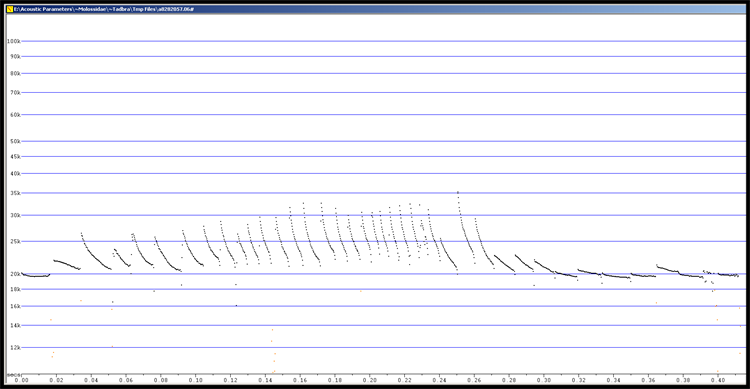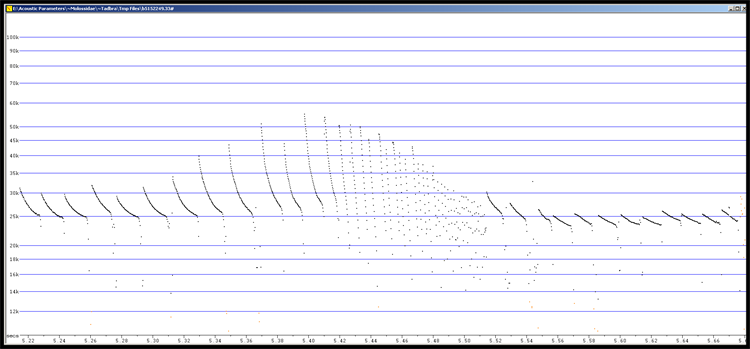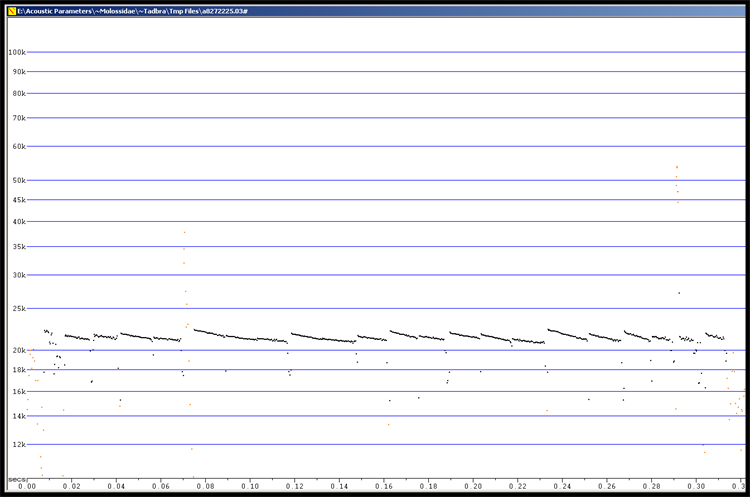Molossidae
Guide for Acoustic Identification of Florida bats
Tadbra or Tabr
See glossary for explanation of codes
Tadarida brasiliensis (I. Geoffroy, 1824)
Taxonomy follows Simmons and Cirranello (2021)
To view call graphics click on the camera icon on the right. You can then move through all images by using the left or right arrow keys. A left mouse click returns to the fact sheet.
QCF single pulses of decreasing frequency may include short FM pulses. Commuting calls may be considerably lower Fc and are "flat looking" narrow band pulses of longer duration. Calls of this species may be quite variable depending on conditions when recorded (Gillam and McCraken, 2007).
Feeding buzz and approach phase calls are variable and shift to broad band pulses that are considerably higher in frequency and shorter duration. Out of the context of complete call sequences these pulses may be mistaken for Vespertilionid calls.
NOTE: AutoID algorithms will likely misclassify such pulses.
| Parameters | N | Min | Max | Mean | St.Dev | 10% | 25% | 75% | 90% |
| Dur | 10,624 | 2.00 | 31.53 | 9.88 | 4.13 | 3.38 | 6.53 | 13.01 | 14.51 |
| TBC | 10,322 | 2.2 | 3469.1 | 236.8 | 159.4 | 71.4 | 156.0 | 302.8 | 369.6 |
| Fmin | 10,624 | 10.94 | 56.34 | 23.39 | 2.43 | 20.62 | 21.86 | 24.84 | 26.40 |
| Fmax | 10,624 | 18.41 | 66.67 | 29.79 | 7.06 | 22.99 | 24.84 | 33.20 | 40.20 |
| BW | 10,624 | 0.11 | 40.42 | 6.40 | 6.33 | 1.10 | 2.03 | 8.66 | 15.62 |
| Fmean | 10,624 | 15.51 | 59.90 | 25.78 | 3.26 | 22.07 | 23.49 | 27.67 | 30.17 |
| Fk | 10,624 | 18.08 | 62.50 | 26.66 | 3.75 | 22.73 | 24.28 | 28.47 | 30.59 |
| FCH1 | 10,624 | 8.37 | 28.17 | 12.35 | 1.63 | 10.76 | 11.35 | 13.10 | 13.94 |
| Fc | 10,624 | 16.74 | 56.34 | 24.71 | 3.26 | 21.51 | 22.70 | 26.19 | 27.87 |
| FcH3 | 10,624 | 25.11 | 84.51 | 37.06 | 4.89 | 32.27 | 34.05 | 39.29 | 41.81 |
| Sc | 10,624 | -212.27 | 499.75 | 33.76 | 58.14 | 3.88 | 8.13 | 28.68 | 80.07 |
| Pmc | 10,624 | 0.00 | 152.40 | 19.95 | 20.11 | 3.20 | 6.50 | 26.50 | 46.70 |
Reported by Szewczak (2018)
| Tadbra | Fc | Fmax | Fmin | FmaxE | dur | uppr slp | lwr slp | slp @ Fc | total slp |
| Mean | 25.5 | 23.3 | 24.1 | 28.0 | 11.5 | 1.6 | 0.5 | 0.4 | 0.7 |
| Max | 28.0 | 39.0 | 26.0 | 31.0 | 14.0 | 3.2 | 0.8 | 1.0 | 1.4 |
| Min | 23.0 | 25.0 | 22.0 | 25.0 | 9.5 | 0.0 | 0.1 | -0.3 | 0.0 |
Cynthia and George Marks
Chris Corben
Reference calls recorded by Marks are being archived at BioAcoustica and will be freely available. See Baker et al., (2015).
Tadarida brasiliensis is one of the most widely distributed mammalian species in the Western Hemisphere (Wilkins, 1989) and has been documented throughout the state.
|
|
Least concern; Ver.3.1 ; Population trend - stable; evaluated 2015. (I.U.C.N. 2017.)
See Baker et. al., (2015) for discussion of BioAcoustica and Baker and Vincent (2019) for a critique of the lack of freely available acoustic data.
Baker, E., B. W. Price, S. D. Rycroft, J. Hill, and V. S. Smith. 2015. BioAcoustica: a free and open repository and analysis platform for bioacoustics. Database. 2015. bav054
Baker, E., and S. Vincent. 2019. A deafening silence: a lack of data and reproducibility in published bioacoustics research? Biodiversity Data Journal 7: e36783.
Gillam, E. H., and G. F. McCracken. 2007. Variability in the echolocation of Tadarida brasiliensis: effects of geography and local acoustic environment. Animal Behavior. 74:277-286.
Marks, C. S., and G. E. Marks. 2006. Bats of Florida. Pp. 176. University of Florida Press, Gainesville.
Simmons, N. B., and A. L. Cirranello. 2020. Bat Species of the World: A taxonomic and geographic database. http://batnames.org
Szewczak, J. M. 2018. Echolocation Call Characteristics of Eastern U.S. Bats. Echolocation call characteristics of Eastern U.S. Bats. Unpublished report.
The IUCN 2017. Red List of Threatened Species. Version 2017-1. www.iucnredlist.org;. Downloaded on August 6, 2017.
Wilkins, K. T. 1989. Tadarida brasiliensis. Mammalian Species. 331:1-10.








